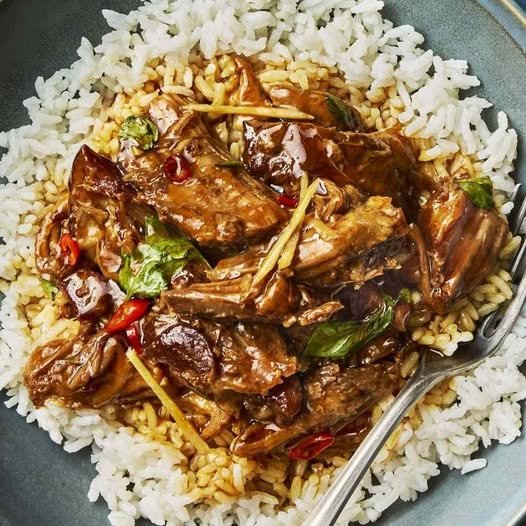Here is a detailed recipe and guide for Three-Cup Pork (三杯猪肉 – Sān Bēi Zhū Ròu), a classic Taiwanese dish.
While “Three-Cup Chicken” (三杯鸡 – Sān Bēi Jī) is the most famous version, the pork variation is equally delicious and follows the exact same iconic formula.
The “Three Cups” refer to the three key liquid ingredients in equal parts:
-
1 cup of soy sauce
-
1 cup of rice wine
-
1 cup of sesame oil
However, a modern take uses slightly less of each to balance the flavors and is cooked down into a rich, glossy sauce.
Three-Cup Pork (三杯猪肉) 🐖
This dish is famous for its intense aroma from basil, ginger, and garlic, and its rich, savory-sweet sauce.
Ingredients (Serves 2-3 as a main)
The Main Components:
-
1 lb (450g) pork shoulder (or pork belly for a richer version), cut into 1-inch cubes
The “Three Cups” Sauce:
-
½ cup Taiwanese rice wine (米酒 – Mǐjiǔ) (Shaoxing wine is a good substitute)
-
¼ cup light soy sauce
-
2 tablespoons dark soy sauce (for color and a less salty flavor)
-
3 tablespoons sesame oil (not the toasted kind for cooking; use regular for frying the aromatics and toasted for finishing)
-
2 tablespoons sugar (rock sugar is traditional, but brown or white sugar works)
The Aromatics (CRUCIAL):
-
1 large thumb of ginger, sliced into 8-10 thick coins
-
8-10 cloves garlic, lightly smashed (peeled)
-
2-3 dried red chilies, deseeded (optional, for a mild heat)
-
1 large bunch of fresh Thai basil (or regular basil if unavailable)
For Cooking:
-
2 tablespoons neutral oil (like vegetable or canola)
-
1-2 tablespoons water, if needed
Instructions
1. Prep the Pork:
-
If using pork shoulder, you can blanch it first for a cleaner taste: place the cubed pork in cold water, bring to a boil for 1-2 minutes, then drain and rinse. Pat dry. (This step is optional but recommended).
-
If using pork belly, you can skip blanching.
2. Toast the Aromatics:
-
Heat a clay pot or a heavy-bottomed pot (like a Dutch oven) over medium heat.
-
Add the neutral oil and the thick slices of ginger. Fry for 2-3 minutes until they start to curl and become fragrant.
-
Add the smashed garlic cloves and dried chilies. Stir-fry for another minute until everything is incredibly aromatic.
3. Brown the Pork:
-
Increase the heat to medium-high. Add the pork cubes and sear until they are lightly browned on all sides.
4. Simmer in the “Three Cups” Sauce:
-
Pour in the rice wine, light soy sauce, and dark soy sauce. Add the sugar.
-
Stir everything to combine, ensuring the pork is coated.
-
Bring the liquid to a boil, then immediately reduce the heat to low. Cover the pot with a lid and let it simmer gently for 30-45 minutes.
-
The simmering time will depend on your cut of meat. Pork shoulder will need longer (closer to 45 mins) to become tender, while pork belly will need less. Check occasionally and add a tablespoon or two of water if the sauce is reducing too quickly before the pork is tender.
5. Reduce the Sauce:
-
Once the pork is tender, uncover the pot. Increase the heat to medium-high to rapidly reduce the sauce.
-
Let it bubble away for 3-5 minutes until the sauce has thickened and become glossy, coating the back of a spoon.
6. The Final, Essential Steps:
-
Drizzle in the 3 tablespoons of toasted sesame oil and stir through.
-
Tear in the huge handful of fresh basil leaves. Stir just until the basil is wilted and its incredible fragrance is released (this should take less than 30 seconds).
-
Remove from heat immediately.
7. Serve:
-
Serve directly from the clay pot (if using) while it’s still sizzling.
-
Perfect with: A large bowl of steamed jasmine rice to soak up the incredible sauce.
Key Tips for Authentic Flavor:
-
The Basil is Non-Negotiable: Thai basil (with its purple stems and licorice-like aroma) is traditional and essential for the authentic taste. Do not substitute with Italian basil if you can avoid it.
-
Ginger and Garlic: Don’t mince them! Thick slices and whole smashed cloves are used so they impart their flavor without disintegrating. They are also delicious to eat!
-
Low and Slow Simmer: This step is crucial for tenderizing the pork and allowing it to absorb all the flavors of the sauce.
-
The Clay Pot: Using a traditional sandy clay pot (沙鍋 – shā guō) helps distribute heat evenly and gives the dish an authentic, rustic presentation. However, a heavy Dutch oven works perfectly fine.
Enjoy your homemade taste of Taiwan! 慢用 (Màn yòng – Enjoy your meal!)
